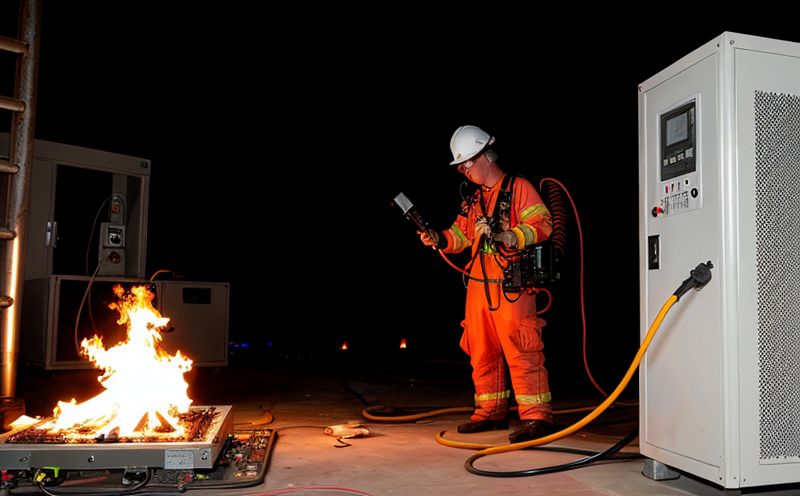Heat Release Rate Measurement of Electronic Devices
The measurement of heat release rate (HRR) is crucial in the fire safety testing of electrical and electronic equipment. This process evaluates how much heat an electronic device generates when exposed to a flame or high temperature, providing valuable insights into its flammability characteristics and potential for self-sustained combustion.
Understanding HRR is particularly important in sectors like consumer electronics, medical devices, and IT infrastructure where safety regulations demand stringent fire safety standards. For quality managers, compliance officers, R&D engineers, and procurement teams involved with these products, accurate and reliable HRR measurements are essential for ensuring product safety and regulatory compliance.
During the testing process, electronic specimens are subjected to controlled conditions that mimic real-world scenarios. Specimen preparation involves selecting appropriate samples based on their size, shape, and material composition. Once prepared, they undergo rigorous testing in a specialized chamber equipped with sensors capable of measuring heat release at various stages.
The instrumentation used for HRR measurement typically includes calorimeters designed specifically for electronic devices. These instruments provide precise data points which are then analyzed to determine the HRR value. Reporting involves generating detailed reports that include raw data, calculated values, and graphical representations such as curves depicting how HRR varies over time.
By accurately measuring HRR, manufacturers can identify potential risks early in the design phase and make necessary adjustments to improve product safety. This proactive approach not only enhances consumer protection but also helps companies avoid costly recalls post-market release.
The process of HRR measurement is governed by several international standards including ISO 56602:2017 for general requirements, ISO 13943-1 and -2 for specific procedures, and ASTM E1350 which covers small-scale burn tests. Adhering to these guidelines ensures consistency across different laboratories worldwide.
It's worth noting that HRR testing is just one aspect of overall fire safety evaluation; other factors such as smoke generation, flame spread rate, and toxicity must also be considered depending on the specific application or regulatory requirements.
Applied Standards
| Standard Number | Description |
|---|---|
| ISO 56602:2017 | General requirements for the determination of heat release rate and other fire test parameters in materials, products, and assemblies. |
| ISO 13943-1 | Standard methods for the determination of heat release rate during flaming combustion using small-scale burners (SST). |
| ISO 13943-2 | Standard methods for the determination of heat release rate during non-flaming combustion. |
| ASTM E1350 | Small-scale burn test apparatus and procedures for materials, products, and assemblies up to about 3 kg in mass. |
Benefits
Accurate HRR measurement offers numerous benefits beyond mere compliance with regulations. It allows manufacturers to identify potential hazards early in the development process, leading to safer products and reduced risk of fires during use.
Moreover, by incorporating this information into their design iterations, companies can enhance product performance while maintaining high levels of safety standards. This proactive approach fosters innovation within industries reliant on reliable fire protection measures.
In addition to improving product quality, accurate HRR measurements contribute significantly towards ensuring user safety and satisfaction. Consumers trust brands that prioritize safety above all else, making it an essential factor in brand reputation management.
From a business perspective, compliance with stringent fire safety regulations helps protect companies from legal action due to accidents caused by non-compliant products. It also builds customer confidence, potentially increasing sales and market share.
International Acceptance and Recognition
The importance of HRR measurement extends beyond national borders as it has gained widespread acceptance globally. Many countries have adopted these standards into their local laws and codes, recognizing the significance of accurate fire safety assessments in protecting public health and property.
Standardization organizations like ISO and ASTM play pivotal roles in promoting uniformity through internationally recognized specifications. Their efforts ensure that regardless of location, consistent methods are employed when conducting HRR tests.
This global alignment facilitates easier trade between nations since products conforming to international standards are more likely to meet local requirements without additional modifications. Consequently, manufacturers benefit from broader access to markets while maintaining a robust safety standard across all regions.





